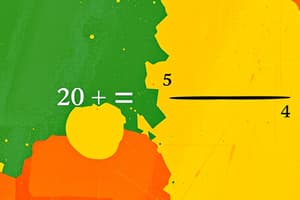Podcast
Questions and Answers
What does the Addition Property of Equality state?
What does the Addition Property of Equality state?
- Subtracting the same number from each side produces an equivalent equation.
- Dividing each side by the same number produces an equivalent equation.
- Adding different numbers to each side produces an equivalent equation.
- Adding the same number to each side produces an equivalent equation. (correct)
What is the Distributive Property?
What is the Distributive Property?
states that to multiply a sum or difference by a number, multiply each number in the sum or difference by the number outside the parenthesis.
The Division Property of Equality states that dividing each side of an equation by different numbers produces an equivalent equation.
The Division Property of Equality states that dividing each side of an equation by different numbers produces an equivalent equation.
False (B)
What are equivalent equations?
What are equivalent equations?
What are like terms?
What are like terms?
What is a linear expression?
What is a linear expression?
What are inverse operations?
What are inverse operations?
What does the Multiplication Property of Equality state?
What does the Multiplication Property of Equality state?
What is the Order of Operations?
What is the Order of Operations?
What is the simplest form of an algebraic equation?
What is the simplest form of an algebraic equation?
What does the Subtraction Property of Equality state?
What does the Subtraction Property of Equality state?
Study Notes
Key Properties and Definitions
-
Addition Property of Equality: Adding the same number to both sides of an equation maintains equality, resulting in an equivalent equation.
-
Distributive Property: When multiplying a sum or difference by a number, distribute the multiplier to each term inside the parentheses before evaluating the expression.
-
Division Property of Equality: Dividing both sides of an equation by the same non-zero number preserves the equality, leading to an equivalent equation.
-
Equivalent Equations: Two or more equations that have the same solution set; they are true for the same value(s) of the variable(s).
-
Like Terms: Terms in an algebraic expression that contain the same variables raised to identical exponents, allowing them to be combined or simplified.
-
Linear Expression: An expression characterized by variables raised only to the first power (exponent of one), reflecting a straight-line relationship when graphed.
-
Inverse Operations: Operations that reverse the effect of each other, such as addition and subtraction or multiplication and division, crucial for solving equations.
-
Multiplication Property of Equality: Multiplying both sides of an equation by the same non-zero number preserves equality and results in an equivalent equation.
-
Order of Operations: A standard sequence to follow when evaluating expressions with multiple operations, often remembered by the acronym PEMDAS (Parentheses, Exponents, Multiplication and Division (from left to right), Addition and Subtraction (from left to right)).
-
Simplest Form: An algebraic expression is in its simplest form when it contains no like terms and no parentheses, making it easy to interpret or solve.
-
Subtraction Property of Equality: Subtracting the same number from both sides of an equation keeps the equation balanced, resulting in an equivalent equation.
Studying That Suits You
Use AI to generate personalized quizzes and flashcards to suit your learning preferences.
Description
Test your understanding of essential math properties in Chapter 3. This quiz features key concepts like the Addition Property of Equality, Distributive Property, and Division Property of Equality. Challenge yourself and reinforce your learning with these flashcards.




